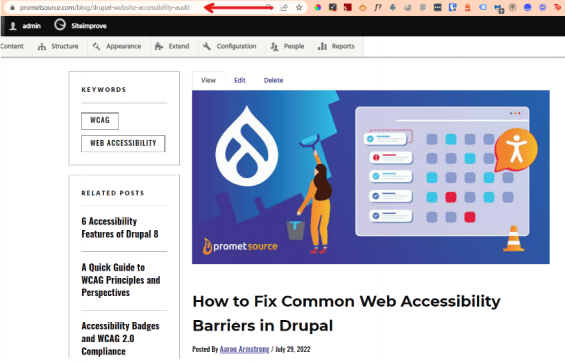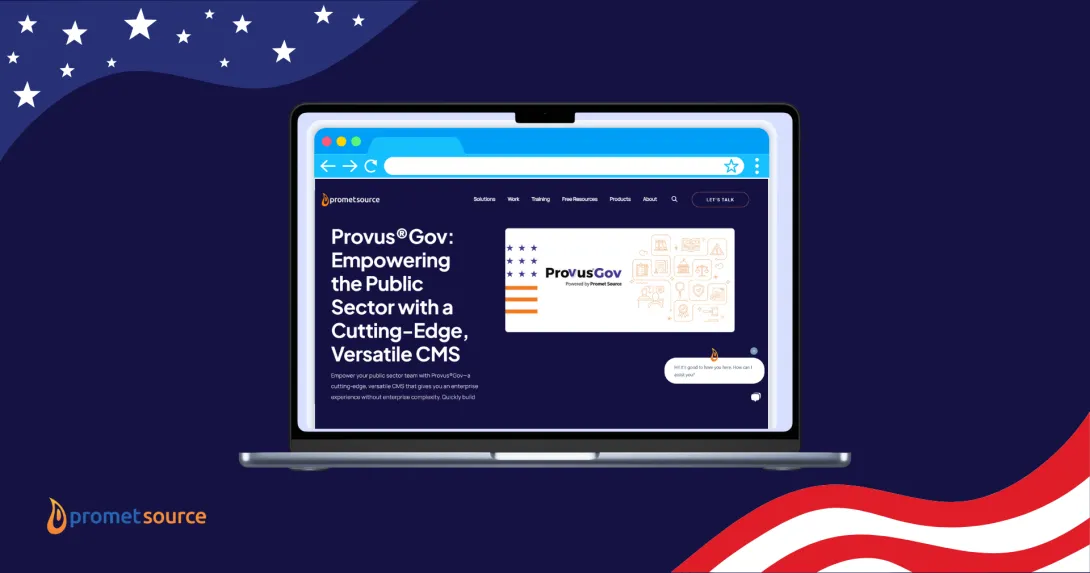Drupal SEO: The Ultimate Guide [2024]

Note: This blog was originally published on November 2, 2022 and has been updated to reflect new information and insights.
Search Engine Optimization or SEO is what we do to ensure our website is as visible as possible to our target markets when they search for topics related to our website on Google, Bing, and other search engines. We do this by optimizing our website for users while following search engine guidelines.
As any SEO professional knows, SEO advice is always changing due to search engine algorithm updates, ranking news, and discoveries by other SEO professionals. 2023 in particular has been a challenging year for SEO due to updates being released one after another (we’ll talk about these in a bit).
However, there are a couple of best practices that we have found to be consistent.
This guide is your ultimate guide to Drupal SEO. In here you will find answers to common questions on SEO specifically for Drupal, consistent best practices, where to look for information when performing an audit, and more.
How was 2023 for SEO?

Google released nine official updates last year, one less than in 2022 and 2021. However, we can see here that the updates were released in succession (February-April, August-November).
And these are the updates that were officially announced—there were also instances of SERP volatility outside of these, leading to speculation of continuous adjustments due to the September 2023 helpful content update and unconfirmed Google updates.
Is Drupal or WordPress better for SEO?
So your website is on Drupal (or you’re thinking of migrating), and if you want to know if ranking is a possibility with this CMS. Although WordPress remains to be the most popular content management system, Drupal is used by 6.42% of the top 10,000 websites.
Since Drupal is considered to be a heavy lifter—taking in large amounts of data and traffic easily—it’s no surprise that it’s used by some of the most famous companies and organizations in the world such as:
- General Electric
- United Nations
- Lenovo
- Council on Foundations
- British Columbia's Knowledge Network
- United States District Court: The Southern District of New York
Based on Aaron’s comparison of Drupal and WordPress, Drupal is second to WordPress not because of SEO capabilities but because it’s easier to use, has more theme options, and is more affordable.
If you don’t need a complex website, WordPress is probably a better option. But if you’re worried about Drupal sites not ranking, there’s no evidence that they don’t.
Does Drupal enable search engine friendly URLs?
It does. Taking a look at one of our recent blog posts, How to Optimize Digital Experiences in Drupal, you will see that there is an option to automatically generate a URL alias:
This is dependent on the H1 you give your blog, which means changing your H1 automatically changes the URL and puts a 301 redirect on it.
You can also choose to not generate the URL alias. For example, we wanted this post to focus on auditing accessibility issues, so we opted to manually put the URL slug.
If we decide that we want to change the URL to reflect the H1, I can just click Generate automatic URL alias and it will do the redirect for me.
Drupal modules for SEO
If anyone tells you that you just need to install a module or plugin and it will solve your SEO issues, I advise you to run the other way.
SEO cannot be done simply through the use of plugins or modules, but I do have to say that they are great for helping out with some technical and on-page SEO tasks.
Here are some modules we have found useful for the Promet site and for clients such as Frank Lloyd Wright Trust:
- Metatag module
- Metatag AI
- Schema.org Metatag
- Simple XML Sitemap
- Redirect
- Pathauto
And here are some modules I have seen recommended that look good to me:
- SEO Checklist
Metatag module
For example, Drupal has a Metatag module that automatically puts in the metatag for you (you can also edit these as you deem fit). You can add basic tags, referrer policies, open graphs, and Twitter cards.
Metatag AI
The Metatag AI module is one our team developed (yay), and it generates metatags based on the information you provide.
Note from our team: If you’re using a paid account, better. The free Open AI account results in erroneous information.
Schema.org Metatag
The Schema.org Metatag module extends the Metatag module above to give you the ability to implement structured data to your site.
Simple XML Sitemap
This sitemap module generates an XML sitemap for your website. When you go to your website[com]/sitemap.xml, you will see something like this that you then can submit to Google Search Console for crawling:
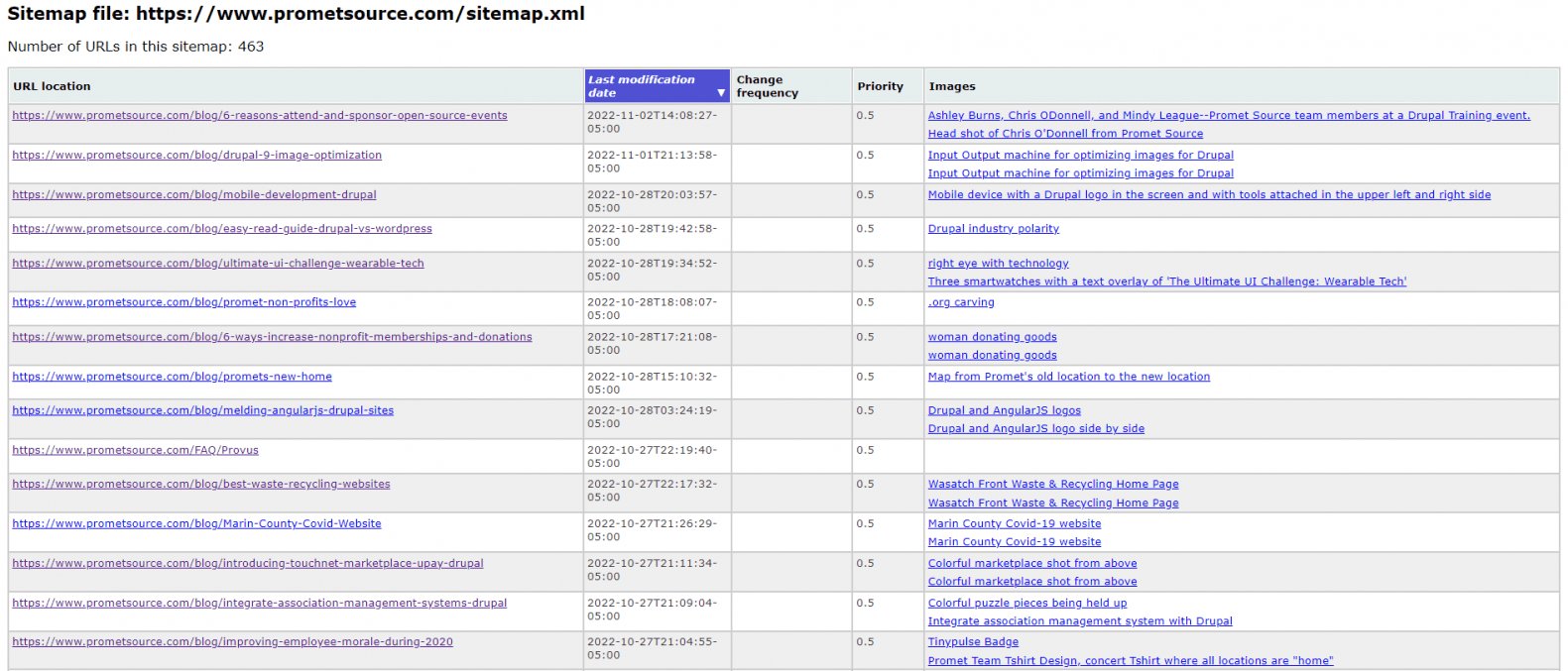
Redirect
Redirects—especially 301 redirects—are essential to ensuring that people are getting to the most relevant pages they need. For example, this blog is the destination URL for a couple of earlier blogs that had thinner content.
With the URL Redirects module, it’s so much easier to apply and keep track of the redirects we have on our website.
Pathauto
As mentioned earlier, Pathauto is a powerful module that allows you to have search engine-friendly URLs and redirects depending on your H1.
SEO Checklist
I’ve seen the SEO Checklist module recommended a few times but I haven’t tried it yet. This module creates an SEO task list for you based on best practices—complete with links to the settings and module recommendations—that you can check off to help you keep track of your progress.
I’m not sure if the task list is configurable. If it is, that would be great!
But again, SEO is so much more than installing modules and calling it a day. So, let’s move on to our checklist.
Drupal SEO checklist
Here’s a quick primer on SEO. SEO is divided primarily into three categories, whether you’re using Drupal or another CMS:
1. Technical factors
Optimizing a website to make it easier for search engines to crawl and index (speed, redirects, directives).
2. On-page factors
Optimizing factors on the web page for search engines and users to easily make sense of their content (titles, meta descriptions, search intent).
3. Off-page factors
Optimizing for how search engines and users perceive your site’s experience, expertise, trustworthiness, and authority (E-E-A-T, incoming links, socials).
Google has over 200 ranking factors, divided into these three groups. Feel free to dive into the 200 here (some of these are speculative, so use your own judgment).
Yes, it can get tedious and confusing. All in all, what I can say is that if you have these three principles as your guiding light, everything will fall into place:
- Relevant, informative content that fulfills search intent;
- Smooth and fast user experiences; and
- High site authority and reputation.
Let’s begin.

How to improve Drupal SEO
In this portion, I will walk you through the process of how I do SEO. This has gone through some improvements in the past year, so I’m excited to share.
Get these tools ready for the entire process:
- Google Analytics
- Google Search Console
- PageSpeed Insights
- Screaming Frog
- Semrush, SE Ranking, or your preferred tool for keyword research
- A spreadsheet to record your changes
Preliminaries
- Start with a Google Search Console audit.
- Audit your site.
- Prioritize your tasks.
1. Start with a Google Search Console audit.
If you haven’t looked at your GSC data in a while, now is a good time. GSC tells you what Google is seeing on your site. This is valuable information and must not be overlooked.
Action Plan:
- Set your timeframe to 16 months to see more data.
- Check click data for branded queries, non-branded queries, branded pages, and non-branded pages.
- Analyze the data. How many queries/pages are there in total for each segment? How many are zero-click? How many are generating clicks?
- Make sure to record your data in a spreadsheet.
2. Audit your site.
We will be using Screaming Frog for this one.
Tip: Make sure to add your Google Analytics, Google Search Console, PageSpeed Insights, and other tools you’d like to pull data from. Don’t forget to add your sitemap as well!

Action Plan:
- Find the optimal settings for you. I use this Screaming Frog settings guide with a few modifications based on the features of our site. It explains what the options are for.
- Perform your audit and note the sitewide issues.
- Head over to the Site Structure tab and check what subfolders (that actually contain content that show up on the site) make up the most of your site structure.
- Identify what subfolders hold the most important pieces of your website. Note the number of URLs.
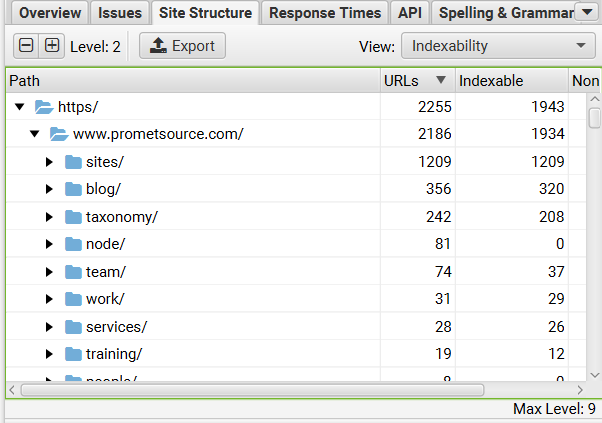
3. Prioritize your tasks.
Now that you have data, it’s time to work on prioritization. Prioritization is up to three things:
- Your capacity
- Developers' capacity
- Impact on site performance
For example, if Screaming Frog is showing a High Priority issue but it’s for three URLs, you probably should reprioritize it (unless it’s a crawling/indexing issue for an important URL) for an Opportunity with 1,500 URLs that can be fixed by a developer in one go.
Action Plan:
- Check what issues affect the most number of URLs and prioritize accordingly.
- Cross-check your subfolder URLs with your Google Search Console data to identify important URLs losing traction.
- Check issues for these important URLs and prioritize accordingly.
- Ticket to developers what you can and QA your tickets!
Now, onto the issues we would normally find in an SEO audit.
Technical SEO
We're working on technical SEO issues first because we want to make sure the site is crawlable, indexable, and usable.
- Review your site structure.
- Secure your website.
- Submit an XML sitemap.
- Upload a robots.txt file to the root directory of your website.
- Check your robots meta tags.
- Check what is being rendered.
- Optimize URL slugs.
- Optimize site speed.
- Fix broken pages and content issues.
- Implement structured data.
- Prioritize mobile-friendliness.
1. Review your site structure.
A poorly designed site structure can confuse your site builders, leaving behind orphan pages. It takes extra time and effort to find these orphan pages and link to them when this happens.
Another issue is click depth. Without a properly planned site structure, important pages can be buried 3 clicks or more, making them difficult to reach for your target audience.
If you see issues with your sitemap, you can solve this by doing some reorganization. Here’s a helpful article by Yoast on the topic.
You can also begin looking for orphan pages so you can check if they need to be linked to, deleted, or left alone.
2. Secure your website.
We will prioritize three things here:
- HTTPS
- Referrer policy
- Mixed content
If you haven’t yet, switch to HTTPS by using a Secure Sockets Layer (SSL). You usually can get this for free depending on your hosting provider. If not, you can speak to your web developers to purchase and activate it.
When you go Overview > Security of Screaming Frog, you should not be seeing any HTTP URLs.
Another important way to secure your website is to use a referrer policy. For WordPress, this is automatically applied, but for Drupal you will have to set it.
We will be using strict-origin-when-cross-origin as it offers more privacy.
You can activate this in global in your site by going to Configuration > Search and metadata > Metatag. From there, you can click Global and scroll down until you see the Referrer policy option, then select Strict Origin When Cross-Origin.

Lastly, check for Mixed Content. These are resources that are being loaded over HTTP even when the actual page itself is HTTPS. You can easily fix these by looking for the bad resources and replacing them with resources loaded over HTTPS.
3. Submit an XML sitemap.
If you haven’t yet, make sure to go to Google Search Console and submit your sitemap there.

4. Upload a robots.txt file to the root directory of your website.
According to Google, "A robots.txt file tells search engine crawlers which URLs the crawler can access on your site." However, it does not prevent Google from indexing your pages. Use a noindex tag for that case.
To verify your robots.txt, simply go to website[com]/robots.txt. If you don’t have one yet, you can follow the instructions here on how to create and upload the file to your website.
5. Check your robots meta tags.
Robots meta tags are the directives that give specific instructions to robots on crawling and indexing your web pages. For example, if I don’t want Google or other search engines to index an archived blog post, I can add a noindex directive on the page.
You can find the pages that have this directive by going to Overview > Directives. Make sure to review the URLs so you know the pages you want indexed do not have the noindex directive.

6. Check what is being rendered.
I first realized that rendering is important to check when I did an audit and realized Google could be seeing something different (or worse, not seeing your site at all) when it renders your website.
For example, JavaScript could be editing your titles, so what you had originally written out and what Google is seeing could be two completely different things. Sitebulb has a great explanation as to when this is or isn't an issue.
Some development teams have chosen to use Drupal as a headless or decoupled CMS. Let's clarifiy what this means, and discuss whether there are any SEO considerations.
Using Drupal as a headless CMS means that you are using the CMS functionality of Drupal to store your content, then another platform to pull through this information and display it for users.
So for example you would log into Drupal as normal and edit/publish your content, but then a platform like Next.js as a front-end framework - which is what users connect to.
This would typically be done via Drupal's JSON:API or Restful Web Services module.
So what are the SEO considerations for this?
The first step is to test what is actually being pulled through to the site. For example, are title tags, SEO meta tags, Open Graph tags and similar being displayed as you would expect?
You should also check if your content is being rendered correctly to ensure that Google can easily access your content.
—Colin McDermott, Head of SEO at Whop.com
7. Optimize URL slugs.
As we discussed earlier, you can automatically generate URL slugs based on your H1. If your H1 is too long, make sure your URL slug is short, clear, yet descriptive.
For example, instead of:
/how-to-perform-seo-to-your-drupal-website-for-2023You can choose:
/how-optimize-drupal-2023It’s much cleaner while giving the same information to your users and the search engines.
But again, don’t go changing your URL slugs if there’s no need. For example, if you refresh a blog, you don’t have to change the URL if it’s already set. Just go to GSC and ask Google to recrawl the page.
8. Optimize site speed.
Some tips to improve site speed for Drupal include reducing the size of images, using a caching module, and optimizing code. PageSpeed Insights can help identify specific ways to improve performance.

Images are often the largest files on a web page, and can significantly slow down loading times. Try to reduce the size of images without compromising quality using Photoshop or an image resizer tool.
You can also check your caching configuration at Configuration > Development > Performance to help speed up loading times by storing frequently accessed files, so they don’t need to be retrieved from the server every single time a user visits your site.
Finally, take a look at the code on your site and see if there are any ways to optimize it for faster loading. This may involve minifying CSS and JavaScript files. Go again to Performance and you’ll see an option to aggregate CSS and JavaScript files under Bandwidth Optimization.
By following these tips, you can help improve the speed of your Drupal site and provide a better experience for your users.
9. Fix broken pages and content issues.
First, let’s talk about broken pages. Check for your URLs that have an HTTP response code of 404 then consider if these should be redirected to a page that is more relevant to your users (if you have them) or if they should be left alone.
If you don’t have a more relevant page on a similar topic, do not redirect to the homepage. You won’t be getting any value from it and your users will only be confused.
John Mueller also said that if the link has been 404 for years, you can just leave it alone instead of redirecting it. I suggest just replacing the 404 link with another one if that’s the case.
For content issues, you can have thin and duplicate content.
If the content of the page does not give value to the users, it needs to be fixed. You don’t necessarily have to pump out 5,000 words—but you do need to make sure that the content is relevant, valuable, and informative.
For duplicate content, make sure to have your canonical links set up. One culprit we find (if we aren’t using the same titles/meta descriptions for different pieces of content) is pagination. Here is an incredibly helpful guide on the topic.
10. Implement structured data.
According to Google, "Structured data is a standardized format for providing information about a page and classifying the page content." For example, you can check this blog which uses the Article schema.
Structured data is a great signal to get the SERP to display your results in a more attractive way to your users. And with zero-click searches, it's important to get those positions as much as possible as well.
This is what the structured data looks like:

To check what information is required for the schema to work, I suggest downloading the Schema Builder for Structured Data extension. When you click on the extension on your toolbar, you’ll see what schema is detected and view their markup, or you can choose a schema type and see its requirements.

To apply the schema, install the Schema.org Metatag module and fill in the necessary details you’ve checked out using the Schema Builder extension. To check the validity of your schema, you can click the extension again and it will show you if you missed any of the required items.
Alternatively, you can insert your code or URL on the Schema Validator and also check it using the Rich Results Test.
11. Prioritize mobile-friendliness.
Having a mobile-friendly website matters to SEO since:
- Websites behave differently on mobile.
- Users engage websites differently than when they’re on desktop.
And since 63% of US searches happen on mobile, it’s essential to ensure your website is mobile-friendly so you can rank both on desktop and mobile.
Since Google has deprecated the Mobile-Friendly Test tool, Mobile-Friendly Test API, and the Mobile Usability report last December 2023, it's recommended to run the tests using Lighthouse in Chrome.
I would also suggest to talk to the QAs in your development team. Here at Promet Source, any change done to our website and our client websites always have to go through QA, and they perform the mobile testing for us to make sure everything is good to go before and after deployment in the live environment.
On-page SEO
- Research your keywords and topics.
- Place keywords in your titles.
- Ensure headers are correct.
- Don't force your keywords.
- Add short, descriptive alt texts to images.
- Ensure links are live and have descriptive anchor texts.
- Write clear and succinct meta descriptions.
- Ensure colors pass the contrast test.
- Perform a content refresh.
- Write helpful content.
1. Research your keywords and topics.
Writing starts with a lot of research—including keyword research. Some people prefer to just use keyword research tools and others believe just Google is good enough. I prefer to use both.

You can use your keyword research tool to help you determine what the ranking sites are for the keyword you're vying for and you can find associated keywords. But don't depend on just the tool (and God forbid, don't depend on AI for your keyword research).
See, keyword research tools aren’t foolproof—here’s a great interview with Mark Williams-Cook, the founder of AlsoAsked—on why zero-volume keywords should not be overlooked.
Simply put, use Google for long-tail keywords and questions people ask about your topic.
Keyword research tools are great for short to medium-tail keywords. It’s also easier to see variations of the keyword you have in mind.
2. Place keywords in your titles.
This is not a hard and fast rule—but I prefer putting keywords at the beginning of the title since it makes it easier for users to understand and remember what your article is about. But if that makes the title awkward, then just make sure the keyword is in your title.
Remember, your title is the first thing your users see when you come up in the search results. If you have a title that tells your reader absolutely nothing about the page, why would they click?
And ultimately, why should Google rank you in the SERPs if users aren't clicking?
Lastly, make sure your titles are different from each other. You can check your Screaming Frog audit results for duplicate titles and meta descriptions.
3. Ensure headers are correct (H1, H2, H3).
The heading tags on your pages (H1, H2, H3, etc.) play an important role in helping search engines and users understand the structure and content of your page.
Well-structured and descriptive headers are helpful context clues. Imagine picking up a book for your research paper—wouldn’t you skim the table of contents to see if its contents are useful to you?
And not just that, proper headers are great for accessibility.
See, screen readers tell the users what headers they’re reading. For example, they would indicate if a header is H2 or H3. So, your disabled users will have a difficult time if your headers are all over the place or improperly formatted.
4. Don't force your keywords.
When optimizing your on-page factors for SEO, it's important to make sure that you're using keywords in the right places. This means using them in your title tags, meta descriptions, headings, and throughout the body of your content.
Placing keywords strategically will help search engines understand what your page is about. This is going to happen naturally as you discuss your content thoroughly.
The problem comes when people treat keywords like they should be peppered on content to the point that it’s just incredibly obvious that the writer is trying to rank the page instead of being useful to the reader. Google (and your reader) hates that.

If you have done proper keyword research, your content will flow.
5. Add short, descriptive alt texts to images.
Images can be a great way to break up your content and make your content look more alive.
They can also help improve your SEO. Images are great for showing examples and extra information to your users without making them go through extra blocks of texts. Plus images can also rank on search engines—which means your content can rank on search engines.
When adding images to your pages, make sure to include descriptive alt texts. This will help people find your images easier on Image Search.
Another reason to put descriptive alt text to your images is that it will help screen readers "read" the image to the users. So if you have an image with an alt text that’s clearly used to add more keywords to the page instead of helping users, it will ruin their user experience.
You can check your Screaming Frog results for images missing their alt texts so you can see if they are decorative images or not.

6. Ensure links are live and have descriptive anchor texts.
Links are an important part of both technical and on-page SEO. They help search engines understand the structure of your site and can be used to pass along authority and value.
They also help users navigate your site better and find information you want them to find.
When adding links to your pages, make sure that they're live and have descriptive anchor text. This will help search engines and users understand better what they're pointing to.
And yes, this is also good for user experience and accessibility. Imagine clicking on a link and finding out that it’s a 404. Isn’t that annoying?
Or you’re using a screen reader and you completely miss a link because the anchor text just says "here." It just doesn’t help anyone.
7. Write clear and succinct meta descriptions.
When writing your meta descriptions, it's important to be clear and concise. You want to make sure that your meta description accurately reflects the content on your page and includes relevant keywords.
But you also don't want to stuff your meta description with too many keywords. The point is to make it easier for users to understand what your page is about while they’re still browsing the SERPs.
Lastly, a good rule of thumb is to keep your meta descriptions around 155 characters just to be sure it’s descriptive enough but not too long that it gets truncated by Google.
Do meta descriptions help with ranking? No, and Google does rewrite meta descriptions if they aren't very helpful. But I like to still work on meta descriptions because that snippet of information can make the difference between a click and no click.

To find which pages on your website to pay attention to for meta descriptions, check out the Meta Description tab on Screaming Frog and filter by results.

8. Ensure colors pass the contrast test.
You need to make sure your page passes the color contrast test. What that means is your foreground color and background color shouldn’t be too similar or shouldn’t hurt the eyes of your readers.
By having a good color contrast (e.g., black text on white background), you help your users—especially colorblind or low vision readers—access your content without giving them a hard time.
And yes, this includes links. Make sure your links are of a different color from the rest of your text, or else your users could pass on potentially important information (or pass on going to another page on your website) just because the link wasn’t obvious.
9. Perform a content refresh.
Remember the URLs you cross-checked from your site structure and GSC audit? If you're seeing a downward trend in their clicks and there isn't much technical work to do on them, I suggest you review the content.
Content decays for a multitude of reasons, so it's good to audit your content and see if they're still relevant and helpful to your target audience.
You can also do this on the top URLs losing clicks on your site. For example:
- Content that used to perform well then began losing traction.
- Content that hasn't performed in a while but are still getting high impressions.
These are worth looking into and refreshing.
10. Write helpful content.
Not all your posts need to be an ultimate guide, but it’s still important that your content is well-thought-out. That’s also why keyword research is important—it doesn’t just tell you what you want to rank for, but what questions people have that you can answer.
Then make sure you answer those questions as clearly and effectively as you can. Here are other things you can do:
- Ensure your content serves your target users.
- Fulfill your users' search intent.
- Give examples and proof.
- Explain jargon and use clear language.
- Add your personal experience on the topic.
- Add other SME's experiences on the topic.
- Proofread your work religiously.
Focus on excellent UX and site speed, but more importantly cited sources and actually answering all the user questions. Find these using the SERP PAA (People Also Ask), customer service, and tools like AlsoAsked. If you nail this you have a great chance of doing excellent in the SERPs. Can you use AI to generate this? Yes, but it's risky. I would only do it with human checks built in.
—Arnout Hellemans, Online Markethink
Some people argue that you cannot leverage AI at all to write helpful content, but Google (and a lot of SEO experts) disagrees. Cassey Bowden, our Director of Marketing, suggests using AI as an assistive tool instead of depending on it for everything.
Some use cases for AI in writing:
- Simplifying your content.
- Proofreading your work.
- Summarizing your sections.
- Suggesting improvements.
Off-page SEO
Building links is perhaps the most important activity for off-page SEO. The more high-quality links you have pointing to your website, the higher your site will rank in search results.
There are a number of ways to build links (this comprehensive guide from Semrush is great) but it’s important to note that off-page SEO is highly dependent on the quality of your onsite content.
You can have the most populated social media calendar and all the journalist contacts in the world, but if your content is poorly done, it will not matter.
Why? Because other people would not share or give precious links to your content if they don’t think it’s valuable or relevant enough to share or link to.
- Optimize your posts for easier sharing.
- Create infographics and other easily shareable visuals.
- Plan your content distribution ahead of time.
- Use tools like HARO and Featured.
- Don’t be a cold-caller.
1. Optimize your posts for easier sharing.
You can optimize your content for sharing in three ways:
- Writing relevant, informative content (as mentioned earlier).
- Writing descriptions that persuade users to click and share.
- Adding an eye-catching image.
You can use the Twitter Cards meta tag to choose what your blog would look like when you post it on Twitter, for example.
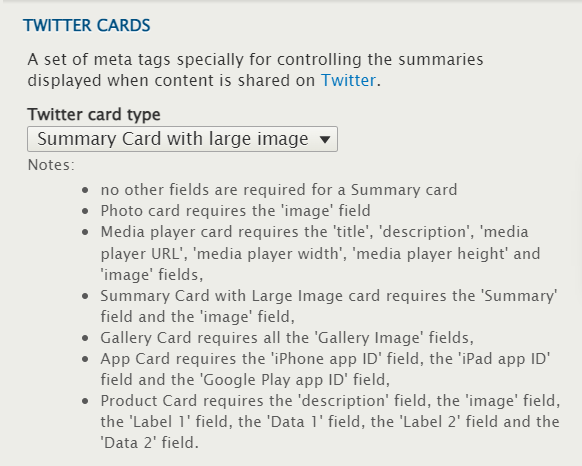
I suggest selecting the Summary Card with large image so it looks like this:
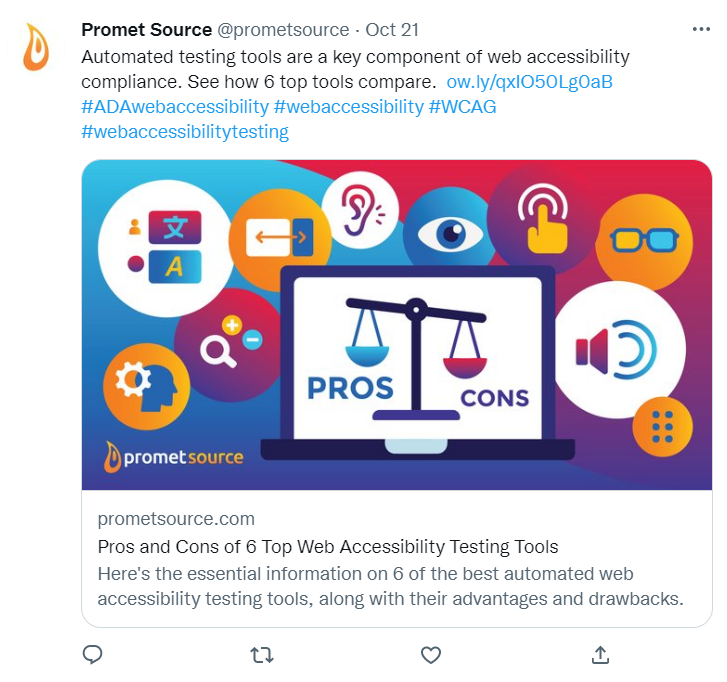
2. Create infographics and other easily shareable visuals.
Another thing people love sharing are infographics and other easily shareable visuals. Visuals are such a powerful tool to give just the right amount of information in a pleasing way.
An image search of "Drupal history infographic" shows us a bunch of beautifully done visuals that are bound to catch our attention. You would want yours to be the same way—not just informative, but eye-catching.
3. Plan your content distribution ahead of time.
The best performing content is often the best distributed content.
—Melanie Deziel, The Content Fuel Framework
Content distribution tends to be an afterthought and is usually not included in SEO plans. I say it should be—since you need to understand how and why you will be distributing your content the way you want to before even conceptualizing the kind of content you will be creating.
For example, would you create YouTube videos of a massive statistics post? Probably not, but you can send that to a journalist who does articles that would need one.
I suggest reaching out to whoever is handling your socials and other members of your team so you can plan out your distribution.
4. Use tools like HARO and Featured.
Using these tools and platforms are the easiest way I've gotten backlinks. We got links by answering queries from American Marketing Association - Colorado about A/B testing in marketing, GoDaddy about Google's helpful content update, and Lightkey.io about SEO to boost discoverability.
You can pitch on behalf of other SMEs in your organization as well, so you don't have to be the one answering all the time.
5. Don’t be a cold-caller.
Lastly, make friends. This, I think, is the most difficult one for off-page SEO.
I firmly believe that no SEO specialist is an island. Aside from ensuring our content is ridiculously relevant and useful, we also need to build relationships with other folks in our community.
Thankfully, there are more and more communities popping up now online (shout-out to the Women in Tech SEO group and the Neurodivergents in SEO group). Joining these communities make it easier to get your SEO questions answered by people who are supportive, and to form friendships with amazing SEO folks.
As the example goes, would you help the unknown number who called you and gave you a sales talk? Probably not. But you would help your friend who asked you a favor.
Off-page SEO can be a long game. So, ensure your content is awesome and make some friends.
Attract your target audience and boost relevant traffic through SEO
SEO is an investment worth having, especially if your audience uses search engines to look for answers to their problems. Optimizing your website means working to be the authoritative source in your field, so that when the time comes that your audience is ready for your product or service, you're at the top of their mind.
SEO is a long game. It typically takes months before you see the fruits of your hard work, and some even see the effects after an official update! But just because it takes months, it doesn't mean you aren't helping yourself now. So be patient, stick with it, and keep optimizing.
Good luck!
Want to hire us to optimize your website instead? Contact us for an audit.
Get our newsletter
Get weekly Drupal and AI technology advancement news, pro tips, ideas, insights, and more.


